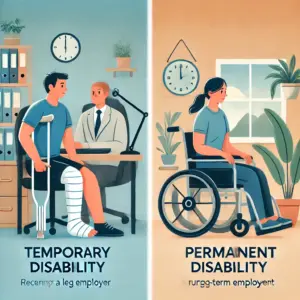Understanding the difference between temporary and permanent disability is crucial for managing your health and finances. When faced with an injury or illness, knowing the type of disability you are dealing with can guide your recovery and improve your quality of life. Temporary disabilities are conditions that limit your ability to work or perform daily tasks for a short time. They offer the hope of recovery and a return to normalcy. In contrast, permanent disabilities persist, requiring long-term adjustments and planning. Both situations involve unique challenges and rights. Recognizing these differences helps you make informed decisions about medical care, legal options, and financial support. Reliable information is key, so seek trustworthy resources and expert advice. To learn more about your rights and assistance options, visit our website. It’s important to equip yourself with the knowledge needed to navigate these complex situations effectively.
What Is a Temporary Disability?
Temporary disability means a condition that prevents you from working for a limited time. These conditions are often due to injuries or illnesses that heal over weeks or months. You might need medical attention, rest, or rehabilitation. During this period, you may be eligible for temporary disability benefits. These benefits help replace lost income while you recover.
It’s important to communicate with your employer about your situation. Keeping them informed helps manage your workload and allows accommodations. Temporary disabilities typically have a clear path to recovery. Understanding this path helps you set realistic expectations and focus on healing.
What Is a Permanent Disability?
Permanent disability refers to conditions that significantly affect your life indefinitely. These conditions might result from severe injuries or chronic illnesses. Permanent disabilities often require ongoing medical care and lifestyle adjustments. Understanding the extent of your disability helps in planning for the future.
You might qualify for permanent disability benefits. These benefits can assist with living costs and medical expenses. Seeking assistance and guidance from experts ensures you get the support you need. Employers and insurance providers often have specific processes for permanent disabilities.
Comparing Temporary and Permanent Disabilities
| Aspect | Temporary Disability | Permanent Disability |
| Duration | Short-term | Long-term |
| Recovery | Possible | Not expected |
| Impact on Work | Temporary loss of ability | Permanent change needed |
| Benefits | Temporary disability benefits | Permanent disability benefits |
Legal Rights and Support
Understanding your legal rights is essential. Workers’ compensation laws provide options for both temporary and permanent disabilities. It’s crucial to know these rights to ensure fair treatment. The U.S. Department of Labor’s website offers information about workers’ compensation.
In addition to workers’ compensation, Social Security Disability Insurance (SSDI) is available for qualifying permanent disabilities. The SSDI program provides financial support to those unable to work. Check eligibility criteria on the Social Security Administration’s website.
Steps to Take After a Disability
- Consult a healthcare provider to understand your condition.
- Communicate with your employer and explore accommodation options.
- Research your eligibility for disability benefits.
- Seek legal advice if you face challenges in accessing your rights.
- Consider joining support groups for emotional and practical support.
Experiencing a disability can be overwhelming. But with the right information and support, you can manage the challenges effectively. Our aim is to provide you with clear and practical advice to help you navigate these situations with confidence.


